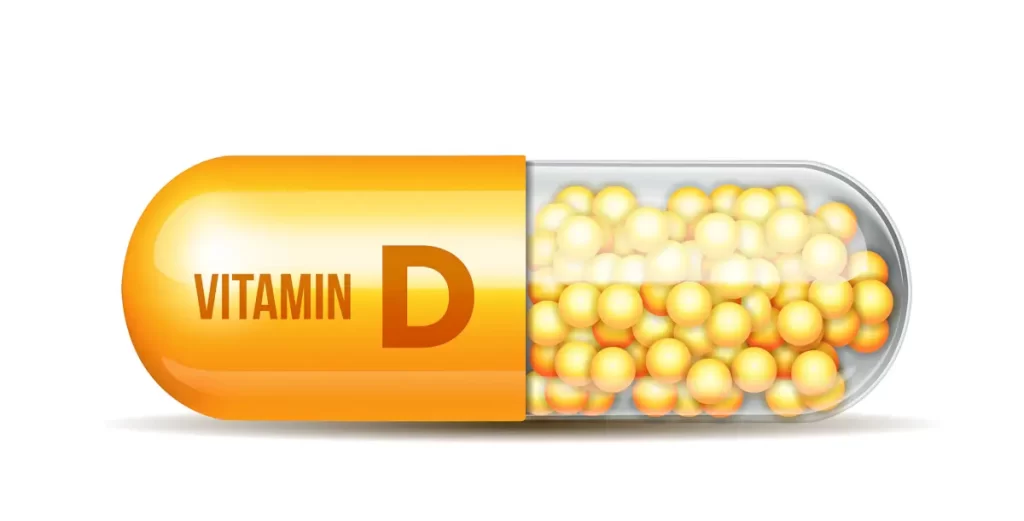Many people struggle with tiredness, weak bones, or low mood without knowing why. Vitamin D, often called the sunshine vitamin, plays a big role in your body’s health. This guide will explain vitamin D’s benefits, sources, and how to prevent deficiency.
Thank you for reading this post, don't forget to subscribe!Keep reading—you don’t want to miss this!
Key Takeaways
- Vitamin D strengthens bones by helping absorb calcium and phosphorus. Deficiency causes rickets in kids and osteomalacia in adults, leading to weak or soft bones.
- Best sources include sunlight (5–30 minutes, 2–3 times a week), fatty fish like salmon, fortified foods such as milk, and supplements like Vitamin D3.
- Daily intake recommendations are 400 IU for infants, 600 IU for ages 1–70, and 800 IU for those over 71 to prevent deficiency and support health.
- High-risk groups include breastfed babies, older adults with low sun exposure, people with darker skin tones, or those with obesity or gastric bypass surgery.
- Too much vitamin D can cause toxicity (over 60,000 IU daily). Signs include nausea, vomiting, weakness, kidney stones, or high blood calcium levels (hypercalcemia).
Essential Functions of Vitamin D
Vitamin D helps your body work better in many ways. It plays a key role in keeping you strong and healthy every day.
Bone health
Strong bones depend on proper calcium absorption. Vitamin D helps the gut absorb calcium and maintains stable levels of calcium and phosphate in the blood. These minerals play a crucial role in bone mineralization, strengthening bone density, and preventing low bone mass.
Without enough vitamin D, children may develop rickets, leading to soft, weak bones. Adults risk osteomalacia or fragile bones that break easily.
This fat-soluble vitamin supports healthy bone growth throughout life. It also prevents muscle spasms caused by low calcium levels (hypocalcemic tetany). Consistent intake can reduce the chance of fractures as you age by encouraging better bone remodeling and maintenance.
Immune system enhancement
Vitamin D does more than keep bones strong; it powers the immune system too. Almost all immune cells have vitamin D receptors (VDR). These help regulate the body’s defenses. The active form, 1,25-dihydroxyvitamin D3, reduces inflammation in tissues and fights harmful bacteria or viruses.
A lack of vitamin D can leave you open to infections and autoimmune diseases like multiple sclerosis or rheumatoid arthritis. Studies link lower levels of this fat-soluble vitamin to higher risks of colds, flu, and other illnesses.
Boosting your intake through sunlight exposure, fortified foods, or supplements helps maintain strong immunity year-round.
Muscle function
Muscle function relies heavily on adequate vitamin D levels. Deficiency can lead to muscle weakness, pain, and a higher risk of falls—especially in older adults. Proximal muscles, like those near the hips and shoulders, are often affected first.
This can make everyday activities like walking or lifting tough.
Research shows mixed results on how much vitamin D improves strength or performance. Some studies suggest it helps build stronger muscles, while others see little effect. Low levels still pose clear risks though—and addressing them may protect mobility and physical health long-term.
Next: – Prevention of osteoporosis

Health Benefits of Vitamin D
Vitamin D offers many benefits for your overall health. It supports key body functions and can help protect against serious conditions.
Prevention of osteoporosis
Strong bones need enough calcium and vitamin D. Adults up to 50 should aim for 1,000 mg of calcium daily, while older adults need 1,200 mg. Pairing this with 600 IU of vitamin D (up to age 70) or 800 IU (for those over 71) supports bone mineral density.
Healthy levels help prevent bone fractures.
Studies show that vitamin D supplements lower fracture risks in older people. Sunlight exposure also boosts vitamin D synthesis naturally. Foods like fatty fish, fortified foods, and egg yolks add extra support.
Meeting these goals can reduce the risk of osteoporosis as you age.
Reduction in cancer risk
A higher Vitamin D level in the blood may lower cancer risks. Studies found that a 50 nmol/L (20 ng/mL) rise in 25(OH)D levels links to an 11% drop in cancer cases. The WHI Trial also showed a 7% decrease in cancer deaths with daily intake of 400 IU Vitamin D3 and calcium.
Research is mixed, though, on whether Vitamin D alone cuts overall cancer rates or saves lives. Some trials show no big changes in these outcomes. Scientists continue exploring if adding Vitamin D to treatments could help fight cancers better.
Lowering the risk of cardiovascular diseases
Vitamin D helps control blood pressure by acting on smooth muscle and endothelial cells. Studies show that every 25 nmol/L (10 ng/mL) gain in vitamin D levels lowers the chance of cardiovascular events by 10%.
These include issues like heart attacks and strokes.
Screening for deficiency is key, especially for people with existing heart conditions. Proper vitamin D intake may support better immune health while reducing certain risks linked to high blood pressure or heart failure.
Alleviation of depression symptoms
Depression often links to low vitamin D levels. Many studies suggest people with depression may be vitamin D-deficient. This fat-soluble vitamin plays a role in mood regulation and brain health.
Increasing intake could help ease symptoms tied to deficiency. A 2020 study, though, showed mixed results—some saw no major improvement with supplements. Still, ensuring proper sun exposure or including sources like fatty fish and egg yolks might support mental well-being.
Management and prevention of diabetes
Vitamin D supports insulin secretion and sensitivity, which helps manage blood sugar. Studies suggest vitamin D may reduce the risk of type 2 diabetes in people with prediabetes. Meta-analyses show slight improvements in glycemic control after using supplements.
Current clinical trials, like D2d and DPVD, are exploring its role further. While results aren’t final yet, proper levels might help lower risks tied to diabetes. Regular sunlight exposure or fortified foods can aid in maintaining sufficient levels for better glucose balance.
Support in weight loss efforts
Higher body weights can lead to lower vitamin D levels. This fat-soluble vitamin often gets trapped in fat cells, making it less available for the body. Studies suggest that taking calcium and vitamin D supplements may help support weight loss.
People deficient in this nutrient might feel more tired or sluggish, affecting their activity levels. Boosting intake through sunlight exposure, fortified foods like milk, or fatty fish could aid your efforts.
Managing your levels might also improve overall health—making exercise and meal plans easier to stick with.
Natural sources of Vitamin D play a key role in maintaining healthy levels…
Natural Sources of Vitamin D
You can get vitamin D from the sun, certain foods, and even supplements—each plays a role in keeping your levels healthy.
Sunlight exposure guidelines
Sunlight helps your body make vitamin D naturally. UVB rays trigger this process, but factors like skin color and age can affect how much you produce.
- Get sunlight for 5-30 minutes, 2-3 times a week between 10 a.m. and 4 p.m., without sunscreen to boost levels.
- People with lighter skin need less sun exposure than those with darker tones to make the same amount of vitamin D.
- Older adults produce less vitamin D due to changes in their skin.
- Use caution—too much sun exposure increases the risk of skin cancer over time.
- Cloudy weather or pollution can block UVB rays, reducing vitamin D production naturally.
- Glass windows filter out UVB light, so sitting indoors by a sunny window won’t help your body make vitamin D.
Food sources rich in Vitamin D
Vitamin D from food is important, especially if sun exposure is limited. Many foods naturally contain this nutrient or are fortified with it.
- Cod liver oil provides the highest amount of vitamin D. Just one tablespoon has 34 mcg (1,360 IU), which equals 170% of your daily value (DV).
- Rainbow trout offers 16.2 mcg (645 IU) in a 3-ounce serving, equal to 81% DV.
- Sockeye salmon contains 14.2 mcg (570 IU) per 3 ounces, contributing to 71% DV for this nutrient.
- Beef liver supplies a smaller amount at only 1 mcg (42 IU) in a 3-ounce portion—a modest 5% DV.
- One large scrambled egg gives you about 1.1 mcg (44 IU), meeting just 6% of the daily recommendation.
Fatty fish like trout and salmon are excellent sources of vitamin D along with cod liver oil as a potent option too!
Benefits of dietary supplements
Supplements help fill gaps in diets. They ensure proper phosphorus absorption and calcium absorption, which supports strong bones and teeth. For people with limited sunlight exposure, supplements prevent vitamin D deficiency.
These products may lower risks of autoimmune diseases like multiple sclerosis (MS) or heart disease. Some studies show they can uplift moods and reduce symptoms of depression or anxiety.
People on vegan diets especially benefit from fortified foods or supplements to maintain immune health.

Vitamin D Deficiency: Identifying and Understanding
Vitamin D deficiency can cause tiredness, weak bones, and mood changes. It often affects people with low sunlight exposure or certain health issues—making awareness crucial.
Symptoms of deficiency
A lack of Vitamin D can affect your body in many ways. It’s important to recognize these symptoms early.
- Bone pain and weakness can occur due to poor calcium absorption. This may lead to serious issues like osteoporosis.
- Muscle cramps or weakness might be noticeable, especially in severe cases of deficiency.
- Fatigue is another common sign that could impact daily activities and energy levels.
- Depression or mood changes, including sadness, may result from low Vitamin D levels affecting brain function.
- Frequent illness might happen due to a weakened immune system tied to insufficient Vitamin D.
- In children, deficiency causes rickets, showing as bowed legs and joint problems.
- Poor wound healing could indicate that the body lacks enough Vitamin D for tissue repair.
- Hair loss can also be linked with prolonged Vitamin D deficiency in some individuals.
- Hypocalcemia develops when calcium levels drop too low because of chronic deficiency.
- Severe cases may lead to secondary hyperparathyroidism, which damages bones further over time.
Recognizing these signs early helps prevent long-term health risks associated with being vitamin D-deficient!
High-risk groups
Some people have a higher chance of developing vitamin D deficiency. This can happen due to lifestyle, age, or specific health conditions.
- Breastfed infants
Breast milk has low levels of vitamin D. Babies who are exclusively breastfed may not get enough unless they take supplements. - Older adults
As people age, their skin produces less vitamin D from sunlight. They also spend more time indoors, increasing the risk of deficiency. - People with darker skin tones
Dark skin contains more melanin, which reduces the ability to produce vitamin D from sunlight exposure. - People with limited sun exposure
Those who stay home often or wear clothing that covers most of their skin can lack adequate sunlight exposure for vitamin D production. - Individuals with obesity
Fat cells store vitamin D, making it less available in the body for use. This increases the risk of being deficient in overweight people. - People after gastric bypass surgery
This procedure alters digestion and affects how the body absorbs vitamins like D and minerals such as calcium. - Individuals with fat absorption issues
Conditions like Crohn’s disease or celiac disease reduce the ability to absorb fat-soluble vitamins like vitamin D properly. - Homebound individuals
Elderly individuals who rarely leave home receive little UVB rays necessary for making vitamin D naturally through their skin.
Breastfed infants
Breast milk contains very low levels of vitamin D. This can make breastfed infants more prone to vitamin D deficiency. Experts suggest supplementing 340-400 IU of vitamin D daily from birth until one year old.
Without enough, infants may develop nutritional rickets between 3 and 18 months.
Rickets causes weak or soft bones. Signs include bone pain, delayed growth, bowed legs, or deformities in the chest and skull. Doctors use clinical exams, X-rays, and blood tests to diagnose it.
Regular supplementation helps avoid these issues in at-risk babies—like those exclusively breastfed without added sources of this fat-soluble vitamin… Older adults also face unique risks for deficiency due to reduced skin production with age!
Older adults
As people age, their skin makes less Vitamin D from sunlight. Older adults often spend more time indoors, reducing sun exposure further. A lack of this fat-soluble vitamin can lead to weak bones and a higher risk of fractures or osteomalacia.
Mild deficiency may cause osteoporosis over time.
Adding fortified foods like milk or cereals helps boost intake. Supplements can also help meet their daily needs safely. Low-dose options taken daily work better than large doses spread out over weeks.
Sunlight exposure remains crucial—just 10-15 minutes outside each day might be enough for some individuals.
Individuals with limited sun exposure
Lack of sun exposure affects millions, increasing the risk of vitamin D deficiency. This is particularly true for people who work indoors or live in areas with limited sunlight. Over 1 billion people globally face this issue, leading to vitamin D levels falling below 30 nmol/L.
Daily intake of 10 micrograms (400 IU) is recommended for those not getting enough sunlight. Deficiency can cause muscle weakness and raise fall risks, especially in older adults. Adjusting dietary habits or using vitamin D supplements can help maintain healthy serum levels.
People with darker skin
People with darker skin produce less vitamin D from sunlight. Higher melanin levels in the skin block UVB rays, which are important for making vitamin D. This makes deficiency more common among African Americans and other groups with darker pigmentation.
Despite lower vitamin D levels, African Americans show fewer osteoporotic fractures. Their bodies may adapt by improving bone strength or resisting the effects of parathyroid hormone.
Still, ensuring proper sun exposure and considering fortified foods or supplements can help prevent deficiencies.

Those with conditions affecting fat absorption
Conditions like Crohn’s disease and celiac disease make it hard to absorb fat. This also affects vitamin D levels since it is a fat-soluble vitamin. People with these issues often face higher risks of deficiency, showing symptoms like bone pain or muscle weakness.
Higher doses of vitamin D supplements may be necessary for those affected. Regular blood tests help monitor their levels. Doctors can adjust treatments based on needs to prevent further health problems.
Next, we will discuss individuals with obesity or post-gastric bypass surgery….
Individuals with obesity or post-gastric bypass surgery
Obese individuals often have lower levels of vitamin D. A negative link exists between BMI and vitamin D in the blood. Fat cells may trap this fat-soluble vitamin, making it harder for the body to use.
Post-gastric bypass patients face another challenge as surgery can reduce nutrient absorption, including that of vitamin D.
Up to 43.2% of bariatric patients had a deficiency before surgery, dropping to 8.9% after one year with care and supplements. Experts recommend taking 800 IU of vitamin D daily along with 1000-1200 mg of calcium after surgery to avoid long-term issues like osteoporosis or bone pain symptoms caused by insufficiency…
…
Preventing Vitamin D Deficiency
Getting enough Vitamin D daily helps keep your body strong and healthy. Simple steps like safe sun exposure and eating nutritious foods can make a big difference.
Recommended daily intakes
Infants need 10 mcg (400 IU) of Vitamin D daily for proper growth. Children aged 1-18 years should aim for 15 mcg (600 IU) to support bone health and immune function.
Adults between 19-70 years also require 15 mcg (600 IU), while those over 70 need more—20 mcg (800 IU). These amounts help maintain calcium absorption, strong bones, and overall health.
Strategic sun exposure
Exposing your skin to sunlight is a key way to boost Vitamin D. Aim for 5-30 minutes, two or three times weekly, between 10 a.m. and 4 p.m. Sunscreen blocks UVB rays needed for production, so skip it during these short windows.
Factors like season, cloud cover, smog, and skin color affect how much you absorb. Urban living often limits sun exposure due to indoor lifestyles or pollution. After ensuring safe sun practices, explore food sources rich in Vitamin D next!
Appropriate dietary choices
Eating the right foods can help maintain healthy Vitamin D levels. This is especially useful if you have limited sunlight exposure.
- Include fatty fish like salmon, mackerel, and tuna in your meals. They are rich in Vitamin D and Omega-3 fats.
- Add egg yolks to your diet. One large egg yolk contains about 37 IU of Vitamin D.
- Consume fortified foods such as milk, orange juice, and cereals. These products often have added Vitamin D to support daily needs.
- Try beef liver for a nutrient-packed option that offers small amounts of Vitamin D along with iron and protein.
- Eat UV-exposed mushrooms like maitake or portobello for a plant-based source suitable for vegans or vegetarians.
- Use cod liver oil if you enjoy supplements from natural sources—one tablespoon provides over 1,300 IU of Vitamin D.
- Combine these foods with healthy fats like olive oil or avocado to boost absorption since Vitamin D is fat-soluble.
Making these dietary choices ensures better calcium absorption and supports immune function naturally!
Supplementation options
Cholecalciferol (Vitamin D3) is the best choice for both preventing and treating deficiency. It helps regulate calcium absorption and supports immune health. Vitamin D supplements come in various forms, like capsules, tablets, liquids, or gummies—making it easy to find what works for you.
Winter months often require higher doses due to less sunlight exposure. The recommended daily intake depends on your age group but usually ranges from 400–800 IU. People with severe deficiencies may need up to 10,000 IU under medical supervision.
Always check with a healthcare provider before starting high-dose supplements.
Vitamin D Overdose: Risks and Symptoms
Too much Vitamin D can harm your health—learn about the warning signs and safe limits to stay healthy.
Identifying toxicity
Taking over 60,000 IU of Vitamin D per day can lead to toxicity. This causes hypercalcemia, which means too much calcium in the blood. Early symptoms include nausea, vomiting, weakness, and frequent urination.
Left untreated, it can cause bone pain or kidney problems. Safe serum levels of Vitamin D should stay at about 50-100 nmol/L (20-40 ng/mL). Watch for these signs if using high doses or supplements regularly.
Health risks associated with excessive Vitamin D
Too much Vitamin D can cause high calcium levels in the blood, or hypercalcemia. This may lead to symptoms like nausea, vomiting, weakness, and frequent urination. Long-term toxicity might result in kidney damage, including painful calcium stones.
Taking over 60,000 IU daily for several months is unsafe and can harm bones and organs. Therapeutic doses should always be managed by a healthcare provider to avoid these severe health problems.
Interactions with other medications
Some medications can interfere with how your body absorbs or uses Vitamin D. These interactions may reduce its effectiveness or cause complications.
- Orlistat can reduce fat absorption, which lowers Vitamin D levels. This medication is used for weight loss but limits the body’s ability to absorb fat-soluble vitamins.
- Statins may decrease the body’s natural production of Vitamin D. These drugs are commonly prescribed to lower cholesterol levels.
- Steroids can impair calcium absorption and reduce Vitamin D metabolism. Long-term use might increase the risk of deficiency.
- Thiazide diuretics combined with Vitamin D and calcium may lead to hypercalcemia (too much calcium in the blood). This combination needs careful monitoring by your doctor.
- Immunosuppressive agents like those used after organ transplants might increase deficiency risks. Regular testing is vital for those on these drugs.
Orlistat
Orlistat, a weight-loss medication, blocks fat absorption in the gut. This process lowers calorie intake and reduces the absorption of fat-soluble vitamins like vitamin D. Over time, this can lead to vitamin D deficiency if levels are not monitored or supplemented properly.
People taking Orlistat should think about using vitamin D supplements or fortified foods to prevent issues like fatigue, bone pain, or weakened immunity caused by low levels. Regular check-ups can help monitor and maintain healthy vitamin D levels while using this medication.
Statins
Statins, while helpful for managing cholesterol, can lower vitamin D levels. These medications impact cholesterol production, a key part of vitamin D synthesis in the body. If you take statins and notice symptoms like bone pain or fatigue, it could signal low vitamin D.
Some people on statins may need extra vitamin D from supplements or more exposure to sunlight. Combining both approaches helps maintain healthy immune function and supports calcium absorption for strong bones.
Always check with your doctor before adjusting your diet or adding supplements alongside these drugs.
Steroids
Steroids can interfere with how Vitamin D works in the body. These medications may lower calcium absorption, which weakens bones over time. People taking steroids for a long period should monitor their bone health closely.
These drugs are often prescribed to reduce inflammation or treat autoimmune diseases like ulcerative colitis and multiple sclerosis. While they help manage such conditions, steroids increase the risk of Vitamin D deficiency.
This makes it crucial for individuals on these medicines to consider supplements or fortified foods rich in Vitamin D.
Thiazide diuretics
Thiazide diuretics can reduce how much calcium your body flushes out in urine. This may lower the risk of weak bones but can also increase calcium in the blood, leading to hypercalcemia.
Using these with vitamin D supplements demands caution.
High calcium levels from thiazides may cause nausea, confusion, or fatigue. People using this drug should talk to their doctor before adding any vitamin D or calcium supplements to avoid serious side effects.

FAQs on Vitamin D
Many people have questions about how Vitamin D works and its role in health. This section clears common doubts and explains important facts about this vital nutrient.
How to quickly raise Vitamin D levels
Get 5-20 minutes of sunlight daily on your face, hands, arms, or legs. UVB rays help your body make Vitamin D naturally. Go outside during midday for the best results. Sunscreen can block its production, so consider short exposure without it.
Eat fatty fish like salmon and mackerel. These are rich in Vitamin D3, which is better absorbed than Vitamin D2 found in plants. Add egg yolks and fortified foods like milk or cereals to meals too.
For faster improvement, take vitamin D supplements as advised by a doctor—effects may take at least seven days to show.
Optimal daily dosage
The recommended daily intake of vitamin D depends on age. Children up to 12 months need 400 IU. Those aged 1 to 70 require 600 IU, while adults over 70 should aim for 800 IU per day.
These amounts help support bone health, immune function, and calcium absorption.
Exceeding the safe limit of 4,000 IU daily can cause vitamin D toxicity. This might lead to nausea, weakness, or kidney problems. Consult a doctor before taking high-dose supplements or making drastic changes to your diet…
especially if you’re at risk of deficiency or have unique health needs.
Vitamin D2 vs. Vitamin D3
Vitamin D2, called ergocalciferol, comes from plants like mushrooms. Vitamin D3, known as cholecalciferol, is made in your body when sunlight hits the skin. Both types help increase vitamin D levels in those with a deficiency.
D3 works better at raising and keeping stable blood levels of vitamin D than D2. This makes it a preferred choice for most people needing supplements. Moving on to natural sources highlights how sunlight and food can boost these levels….
The necessity of supplements for different age groups
Infants need 400 IU of Vitamin D daily to support healthy growth. Breastfed babies often require supplements, as breast milk alone may not provide enough. Children older than one year should aim for 600 IU daily to maintain strong bones and immunity.
Adults up to 70 years also benefit from 600 IU each day, but those over 70 need about 800 IU. Older adults often absorb less Vitamin D due to aging skin and limited sun exposure. Supplements can help fill this gap—especially in high-risk groups like individuals with darker skin or obesity…
Next, let’s explore the impact of Vitamin D on specific health conditions!
The Impact of Vitamin D on Specific Health Conditions
Vitamin D plays a huge role in managing certain diseases. It supports overall health and may improve conditions like bone disorders or mental illnesses.
Bone disorders
Low Vitamin D levels can weaken bones. A deficiency reduces calcium and phosphorus absorption, leading to brittle bones. In children, it causes rickets, where bones soften and bow.
For adults, osteomalacia develops, causing bone pain and muscle weakness.
Without enough Vitamin D, osteoporosis risk increases too. This condition thins bones over time, making them fragile. Serum 25-hydroxyvitamin D levels below 20 ng/mL signal a deficiency needing attention.
Autoimmune diseases
Autoimmune diseases happen when the immune system attacks healthy body parts. Conditions like multiple sclerosis (MS), type 1 diabetes (T1DM), and systemic lupus erythematosus (SLE) are linked to low Vitamin D levels.
This fat-soluble vitamin supports immune health, and its deficiency may worsen these issues.
Genetic variations in the Vitamin D receptor (VDR) also seem to raise the risk of autoimmune conditions. Studies suggest proper sunlight exposure or supplements may help immune function, but more research is needed to prove this fully.
Mental health issues
Vitamin D plays a role in mental health. Low levels may increase symptoms of depression and anxiety. People with vitamin D deficiency might experience mood swings or feelings of sadness.
Studies show high levels can lower the risk of developing depressive symptoms.
Supplementation helps improve mood and ease anxiety for some individuals. Monitoring serum levels is important, especially if you face ongoing stress or mood issues. Healthy exposure to sunlight, consuming fortified foods, or taking vitamin D supplements can help maintain proper levels needed for brain function and emotional well-being.
Latest Research and Developments
Scientists continue to explore how Vitamin D impacts overall health. New studies reveal its potential in managing chronic conditions and improving immune response.
Innovations in supplementation
New options for vitamin D supplementation are improving health outcomes. Personalized plans now match individual needs, using factors like age, lifestyle, and genetic markers. A 2023 study highlighted better results in conditions like COPD when doses were customized.
This approach could lower the risk of exacerbations and improve quality of life.
Research also focuses on faster-absorbing forms of vitamin D2 and D3. These advanced formulas help people with absorption issues or certain medical conditions. Fortified foods now contain higher amounts to target deficiency in high-risk groups—offering another simple solution for boosting levels daily.
New findings on Vitamin D’s role in health
Low levels of vitamin D are now linked to higher risks of respiratory infections, autoimmune diseases, and certain cancers. Studies show people with insufficient levels may face an increased chance of depression.
For example, research connects low vitamin D to mental health issues like seasonal affective disorder (SAD).
Supplementation shows promise in managing conditions like COPD and PCOS. Recent findings also suggest it might aid immune health by enhancing defense against illnesses. These discoveries highlight its role beyond just bone health and calcium absorption.
Conclusion
Vitamin D plays a big role in keeping your body strong and healthy. It supports bones, boosts the immune system, and affects many other functions. You can get it from sunlight, food, or supplements.
Preventing deficiency is simple with smart choices and awareness. Stay informed to enjoy its full health benefits!
To explore another essential nutrient and its impacts on your health, check out our comprehensive guide to Vitamin E: Antioxidant Benefits, Dietary Sources, and Health Impact.
